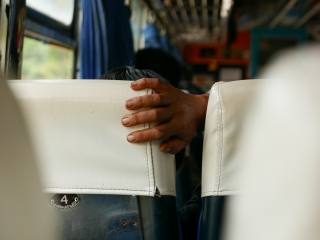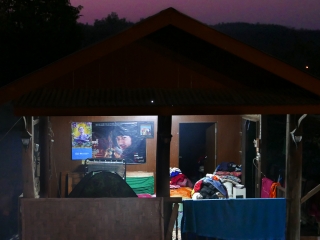“If you want, I jump in water now,” a sixteen-year-old Mon boy in denim shorts says to me as we both look down at a river 40 meters below us.
We are on the Mon Wooden Bridge, the longest wooden bridge in Thailand (400 meters) and an emblem of Sangkhlaburi, as it connects the Thai and Mon sides of the village. It is still quite dark, the stars visible in the sky, fog rising out of the waters, the birds loudly chirping in anticipation of the sunrise. And chilly, the first time I feel cold in one month of travel. Dagi, the Mon boy, is shaking as well, and still he is eager to jump in the cold river. I make him tell me about his family instead. He lives with his mother, who doesn’t earn much, so he started to work early in his life. Jumping off the Mon bridge in exchange for tourist tips is his main source of income. After a short while he manages to gather quite a crowd around him, not least because he speaks confidently and has a well-built body.
Others too are making a living on the bridge in the early morning hours. Mon children in traditional clothes, painted with thanaka powder on their faces, are selling flowers or posing for photos. Mon women are selling food offerings for the monks and an overwhelming variety of handwoven textiles. Mon men are inviting people down to the pier for a boat trip. From the Thai side of the bridge, groups of tourists are pouring in, parading their selfie sticks in all directions. The sun is just rising and the place is teeming with life and transactions.

I continue to the Mon side and head to the morning market for breakfast. Suddenly I find myself in another cultural universe which has little in common with the Thai universe that I had just begun to grasp. The Mon built on Thai soil a replica of their home back in Burma and, from clothing to precepts, preserved their way of life. They seem outgoing and daring, with the quickness of reaction of those who don’t miss any opportunity, and at the same time are very focused on their work. At the market, fierce energetic women dangling butcher knives, carrying impressive loads on their heads or smoking dubious cigars are in charge of the place, while their men, dressed in traditional long skirts, are chitchatting on the sides. The sun is just beginning to penetrate the darkness of the low-hanging canopy. I stand on the edge for a while and watch how people, objects, and animals are coming out of the dark, the rugged contours of the light rendering them completely unfamiliar. Almost a surreal place, offering plenty of fabric for stories.

It isn’t just the social organization and external appearance that the Mon people kept intact, but also their internal clock. My first weeks in provincial Thailand have already challenged my ingrained city-dweller expectation of finding some action in my surroundings regardless of the moment of the day. All the more so in the Mon village: when I cross the bridge again in the afternoon, all the shops and food stalls are closed, a piece of cloth hanging over the entrance, the market empty, barely a few people in the streets. It is only by accident that I find an open restaurant. A beautiful Mon teenage girl in a traditional orange dress is busying about and I ask her with a mix of language and signs whether she has any vegetable soup. She takes the lid off a steaming pot in which a myriad chicken feet are simmering with their claws up in a nondescript broth.
“Chicken soup,” she smiles to me.
Since language fails, I resort to mime and pretend to be her going through the food baskets, selecting some sprouts and herbs, and putting them in a soup bowl. She gets my point and I get a tasty soup a few minutes later. Its hotness melts the heat of the afternoon for a while.
But besides this girl who was probably too kind to turn me away, the place is dead and, as much as I try, I can’t find anything to entertain my curiosity. The Mon unwritten rule is to halt all activity at this time of the day. I have no choice but to synchronize with the tempo of my surroundings – the best lesson that I can learn from a people who, for their part, firmly refused to do so.
















Leave a Reply